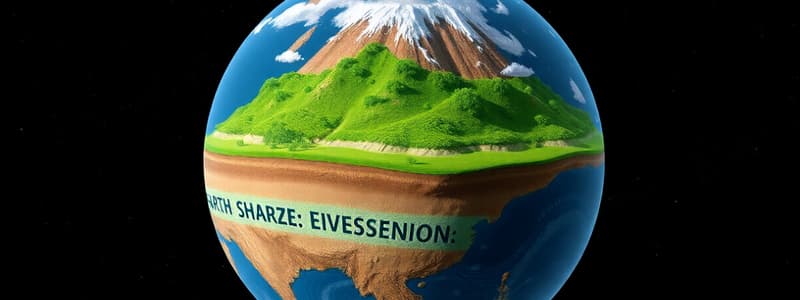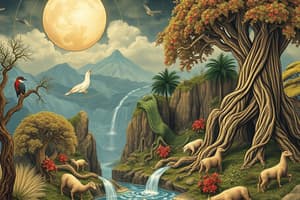Podcast
Questions and Answers
Which of the following scenarios best illustrates the interaction between the geosphere and the atmosphere?
Which of the following scenarios best illustrates the interaction between the geosphere and the atmosphere?
- The absorption of carbon dioxide by ocean waters.
- The formation of clouds leading to rainfall over mountainous regions.
- A volcanic eruption releasing gases and ash into the air. (correct)
- The erosion of coastlines due to strong wave action.
If a large-scale deforestation event occurs, which primarily involves the removal of a significant portion of a forest, which of the following is the most direct impact on the interaction between Earth's spheres?
If a large-scale deforestation event occurs, which primarily involves the removal of a significant portion of a forest, which of the following is the most direct impact on the interaction between Earth's spheres?
- Increased volcanic activity as the removal of trees destabilizes the Earth’s crust.
- Reduced cloud formation due to decreased evapotranspiration affecting the atmosphere and hydrosphere. (correct)
- A decrease in the salinity of ocean water due to reduced land runoff.
- An increase in the geosphere’s mass due to the accumulation of dead organic matter.
How does the hydrosphere most significantly influence the geosphere over extended periods?
How does the hydrosphere most significantly influence the geosphere over extended periods?
- Through weathering and erosion processes that shape landforms. (correct)
- By altering wind patterns through ocean currents.
- By trapping gases that are released from the Earth’s crust.
- Through animal migration patterns influencing the distribution of plant life.
Which of the following best describes the role of clouds in the interaction between the hydrosphere and the atmosphere?
Which of the following best describes the role of clouds in the interaction between the hydrosphere and the atmosphere?
What is a primary way that the biosphere affects the composition of the atmosphere?
What is a primary way that the biosphere affects the composition of the atmosphere?
Flashcards
Biosphere
Biosphere
All living organisms on Earth, including animals, microscopic life, and plants.
Geosphere (Lithosphere)
Geosphere (Lithosphere)
Earth's crust, from the seafloor to mountain tops, including the inner layers.
Hydrosphere
Hydrosphere
All water on Earth, in solid, liquid, or gaseous form. Oceans make up 97%.
Atmosphere
Atmosphere
Signup and view all the flashcards
Sphere Interactions
Sphere Interactions
Signup and view all the flashcards
Study Notes
- Earth is approximately 4.6 billion years old and possesses unique subsystems that comprise its living and non-living components.
- These subsystems are categorized into living organisms, land, water, and air.
- They are also known as the biosphere, geosphere (or lithosphere), hydrosphere, and atmosphere, respectively.
Biosphere
- It includes all living organisms on Earth, from animals and microscopic life to plants.
Geosphere (Lithosphere)
- It encompasses Earth's crust, from the oceanic crust to mountain ranges.
- It also includes the inner layers of the Earth.
Hydrosphere
- It contains all water on Earth in solid, liquid, and gaseous states.
- It includes freshwater, rivers, streams, and the ocean with the latter making up 97% of Earth's water.
Atmosphere
- It comprises all the gases, water vapor, and clouds in the sky.
- It extends from Earth's surface to over 6,200 miles high.
- Clouds are a part of both the hydrosphere and atmosphere.
Interactions Between Spheres
- Each sphere has a vital role and interacts with others.
- The atmosphere interacts through weather patterns.
- Weather affects the hydrosphere through rain and tides.
- The hydrosphere shapes the geosphere through erosion and flooding.
- Volcanic eruptions demonstrate geosphere-atmosphere interaction, releasing gases into the atmosphere.
- The biosphere influences the atmosphere, for example, humans contributing to greenhouse gases.
- These interactions drive Earth as a single system, influencing climate, geological processes, and life.
- It is difficult to define where one sphere begins and ends due to the level of overlap.
- Living organisms rely on the hydrosphere, atmosphere, and geosphere for survival.
- Materials on Earth are reused and recycled as matter changes phases.
Additional Examples of Spheres Interacting
- Plants need soil to grow, which comes from the geosphere.
- Lava cools in the atmosphere bringing nutrients for plants.
- Plants require fresh water from the hydrosphere along with oxygen from the atmosphere in order to photosynthesize.
- Plants decay and are recycled.
Atmosphere and Hydrosphere Interactions
- The atmosphere and hydrosphere supply the biosphere with water and air.
- Water vapor from the hydrosphere rises into the atmosphere and forms clouds.
- Clouds release water as rain.
- Wind from the atmosphere creates ocean waves in the hydrosphere, oxygenating the water.
- Oceans absorb carbon dioxide from the atmosphere.
Biosphere and Geosphere Interactions
- Many organisms rely on the geosphere for shelter by creating burrows.
- Groundwater in the geosphere is used by organisms.
- Volcanoes demonstrate geosphere-biosphere interaction, with lava flows disrupting life.
- Expanding populations residing near volcanoes are vulnerable to the impacts of eruptions.
Studying That Suits You
Use AI to generate personalized quizzes and flashcards to suit your learning preferences.




